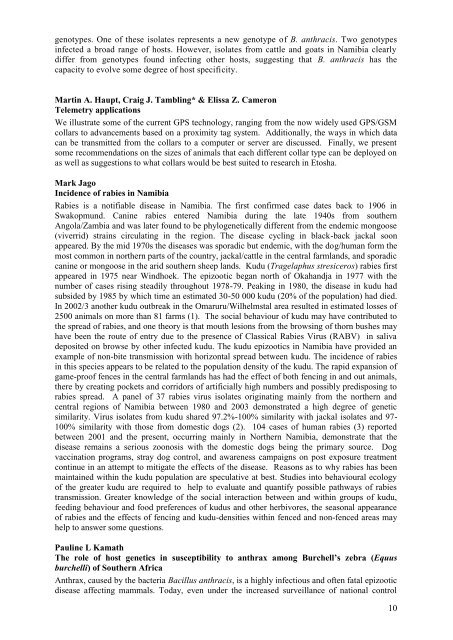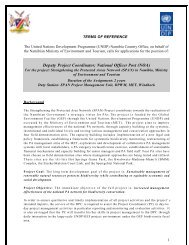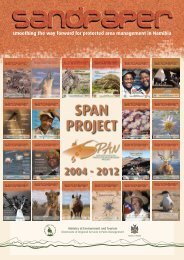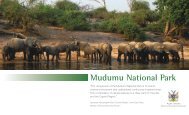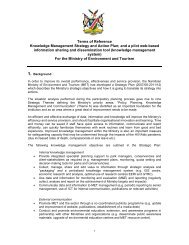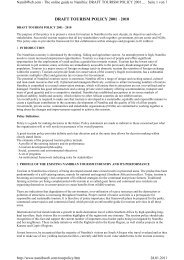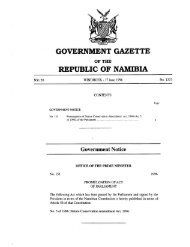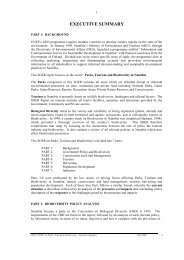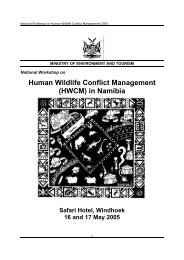Etosha: the Human Footprint - Ministry of Environment and Tourism
Etosha: the Human Footprint - Ministry of Environment and Tourism
Etosha: the Human Footprint - Ministry of Environment and Tourism
You also want an ePaper? Increase the reach of your titles
YUMPU automatically turns print PDFs into web optimized ePapers that Google loves.
genotypes. One <strong>of</strong> <strong>the</strong>se isolates represents a new genotype <strong>of</strong> B. anthracis. Two genotypes<br />
infected a broad range <strong>of</strong> hosts. However, isolates from cattle <strong>and</strong> goats in Namibia clearly<br />
differ from genotypes found infecting o<strong>the</strong>r hosts, suggesting that B. anthracis has <strong>the</strong><br />
capacity to evolve some degree <strong>of</strong> host specificity.<br />
Martin A. Haupt, Craig J. Tambling* & Elissa Z. Cameron<br />
Telemetry applications<br />
We illustrate some <strong>of</strong> <strong>the</strong> current GPS technology, ranging from <strong>the</strong> now widely used GPS/GSM<br />
collars to advancements based on a proximity tag system. Additionally, <strong>the</strong> ways in which data<br />
can be transmitted from <strong>the</strong> collars to a computer or server are discussed. Finally, we present<br />
some recommendations on <strong>the</strong> sizes <strong>of</strong> animals that each different collar type can be deployed on<br />
as well as suggestions to what collars would be best suited to research in <strong>Etosha</strong>.<br />
Mark Jago<br />
Incidence <strong>of</strong> rabies in Namibia<br />
Rabies is a notifiable disease in Namibia. The first confirmed case dates back to 1906 in<br />
Swakopmund. Canine rabies entered Namibia during <strong>the</strong> late 1940s from sou<strong>the</strong>rn<br />
Angola/Zambia <strong>and</strong> was later found to be phylogenetically different from <strong>the</strong> endemic mongoose<br />
(viverrid) strains circulating in <strong>the</strong> region. The disease cycling in black-back jackal soon<br />
appeared. By <strong>the</strong> mid 1970s <strong>the</strong> diseases was sporadic but endemic, with <strong>the</strong> dog/human form <strong>the</strong><br />
most common in nor<strong>the</strong>rn parts <strong>of</strong> <strong>the</strong> country, jackal/cattle in <strong>the</strong> central farml<strong>and</strong>s, <strong>and</strong> sporadic<br />
canine or mongoose in <strong>the</strong> arid sou<strong>the</strong>rn sheep l<strong>and</strong>s. Kudu (Tragelaphus stresiceros) rabies first<br />
appeared in 1975 near Windhoek. The epizootic began north <strong>of</strong> Okah<strong>and</strong>ja in 1977 with <strong>the</strong><br />
number <strong>of</strong> cases rising steadily throughout 1978-79. Peaking in 1980, <strong>the</strong> disease in kudu had<br />
subsided by 1985 by which time an estimated 30-50 000 kudu (20% <strong>of</strong> <strong>the</strong> population) had died.<br />
In 2002/3 ano<strong>the</strong>r kudu outbreak in <strong>the</strong> Omaruru/Wilhelmstal area resulted in estimated losses <strong>of</strong><br />
2500 animals on more than 81 farms (1). The social behaviour <strong>of</strong> kudu may have contributed to<br />
<strong>the</strong> spread <strong>of</strong> rabies, <strong>and</strong> one <strong>the</strong>ory is that mouth lesions from <strong>the</strong> browsing <strong>of</strong> thorn bushes may<br />
have been <strong>the</strong> route <strong>of</strong> entry due to <strong>the</strong> presence <strong>of</strong> Classical Rabies Virus (RABV) in saliva<br />
deposited on browse by o<strong>the</strong>r infected kudu. The kudu epizootics in Namibia have provided an<br />
example <strong>of</strong> non-bite transmission with horizontal spread between kudu. The incidence <strong>of</strong> rabies<br />
in this species appears to be related to <strong>the</strong> population density <strong>of</strong> <strong>the</strong> kudu. The rapid expansion <strong>of</strong><br />
game-pro<strong>of</strong> fences in <strong>the</strong> central farml<strong>and</strong>s has had <strong>the</strong> effect <strong>of</strong> both fencing in <strong>and</strong> out animals,<br />
<strong>the</strong>re by creating pockets <strong>and</strong> corridors <strong>of</strong> artificially high numbers <strong>and</strong> possibly predisposing to<br />
rabies spread. A panel <strong>of</strong> 37 rabies virus isolates originating mainly from <strong>the</strong> nor<strong>the</strong>rn <strong>and</strong><br />
central regions <strong>of</strong> Namibia between 1980 <strong>and</strong> 2003 demonstrated a high degree <strong>of</strong> genetic<br />
similarity. Virus isolates from kudu shared 97.2%-100% similarity with jackal isolates <strong>and</strong> 97-<br />
100% similarity with those from domestic dogs (2). 104 cases <strong>of</strong> human rabies (3) reported<br />
between 2001 <strong>and</strong> <strong>the</strong> present, occurring mainly in Nor<strong>the</strong>rn Namibia, demonstrate that <strong>the</strong><br />
disease remains a serious zoonosis with <strong>the</strong> domestic dogs being <strong>the</strong> primary source. Dog<br />
vaccination programs, stray dog control, <strong>and</strong> awareness campaigns on post exposure treatment<br />
continue in an attempt to mitigate <strong>the</strong> effects <strong>of</strong> <strong>the</strong> disease. Reasons as to why rabies has been<br />
maintained within <strong>the</strong> kudu population are speculative at best. Studies into behavioural ecology<br />
<strong>of</strong> <strong>the</strong> greater kudu are required to help to evaluate <strong>and</strong> quantify possible pathways <strong>of</strong> rabies<br />
transmission. Greater knowledge <strong>of</strong> <strong>the</strong> social interaction between <strong>and</strong> within groups <strong>of</strong> kudu,<br />
feeding behaviour <strong>and</strong> food preferences <strong>of</strong> kudus <strong>and</strong> o<strong>the</strong>r herbivores, <strong>the</strong> seasonal appearance<br />
<strong>of</strong> rabies <strong>and</strong> <strong>the</strong> effects <strong>of</strong> fencing <strong>and</strong> kudu-densities within fenced <strong>and</strong> non-fenced areas may<br />
help to answer some questions.<br />
Pauline L Kamath<br />
The role <strong>of</strong> host genetics in susceptibility to anthrax among Burchell’s zebra (Equus<br />
burchelli) <strong>of</strong> Sou<strong>the</strong>rn Africa<br />
Anthrax, caused by <strong>the</strong> bacteria Bacillus anthracis, is a highly infectious <strong>and</strong> <strong>of</strong>ten fatal epizootic<br />
disease affecting mammals. Today, even under <strong>the</strong> increased surveillance <strong>of</strong> national control<br />
10


